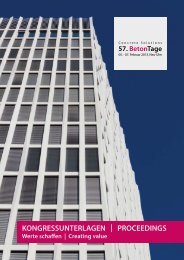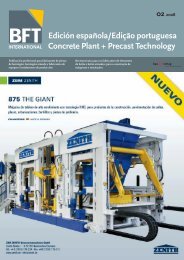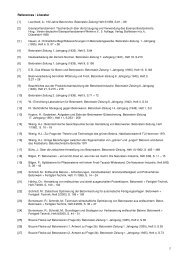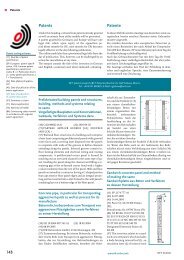Concrete Plant + Precast Technology Betonwerk ... - BFT International
Concrete Plant + Precast Technology Betonwerk ... - BFT International
Concrete Plant + Precast Technology Betonwerk ... - BFT International
Sie wollen auch ein ePaper? Erhöhen Sie die Reichweite Ihrer Titel.
YUMPU macht aus Druck-PDFs automatisch weboptimierte ePaper, die Google liebt.
54. BetonTage Kongressunterlagen |<br />
Fig. 2 Environmental impact of various structural systems.<br />
Abb. 2 Umweltauswirkungen verschiedener Tragsysteme.<br />
tural systems with a fl exible structure, an environmental<br />
assessment was carried out for the design and construction<br />
of the load-bearing structure. When determining the<br />
quantities of building materials, it becomes apparent that<br />
the steel quantity increases as the amount of concrete<br />
used decreases. The standard residential structure with its<br />
high ratio of load-bearing walls results in the consumption<br />
of large amounts of concrete and low steel quantities.<br />
By contrast, the fl exible structure that includes only a minimum<br />
of vertical structural members consumes about<br />
twice the amount of steel. At the same time, however of<br />
higher strength classes about 40% less concrete is required.<br />
The environmental impacts of the three structural<br />
systems assessed are within a range of ± 20%. It was found<br />
that the fl oor slabs account for the largest share in all impact<br />
categories (Fig. 2). As a result, structural fl oor systems<br />
are of particular signifi cance when it comes to the<br />
environmental assessment and design of load-bearing<br />
structures suitable for fl exible use. The environmental<br />
analysis shows that building structures designed for fl exible<br />
use have a higher environmental impact in relation to<br />
the design and construction of the load-bearing structure<br />
than currently applied construction methods.<br />
However, this can be more than compensated over the<br />
entire life cycle due to the longer service life and the fact<br />
that vacant spaces can be largely avoided because of the<br />
adaptability of the building. Overall, building structures<br />
designed for fl exible use thus contribute to sustainable<br />
development.<br />
<strong>BFT</strong> 02/2010<br />
Standard residential/Standard-Wohnen<br />
Standard offi ce/Standard-Büro<br />
Flexible structure/Flexible Struktur<br />
Total primary energy<br />
Primärenergie<br />
gesamt [MJ]<br />
Global warming<br />
potential<br />
Treibhauspotenzial<br />
[kg CO 2 -Äqu.]<br />
Eutrophication potential<br />
Überdüngungspotenzial<br />
[kg P0 4 -Äqu.]<br />
Ozone depletion<br />
potential<br />
Ozonabbaupotenzial<br />
[kgR11-Äqu.<br />
Photochemical<br />
Ozone creation<br />
potential<br />
Ozonbildungspotenzial<br />
[kgC2H4-Äqu.]<br />
Podium 1<br />
Column/Stütze<br />
Wall/Wand<br />
Floor/Decke<br />
Acidifi cation<br />
potential<br />
Versauerungspotenzial<br />
[kg Sox-Äqu.]<br />
Minimum an vertikalen Traggliedern weist dagegen<br />
einen etwa doppelt so hohen Stahlverbrauch auf. Gleichzeitig<br />
wird etwa 40 % weniger, jedoch hochfester Beton<br />
benötigt.<br />
Die Umweltauswirkungen der drei untersuchten<br />
Tragsysteme liegen im Bereich von ±20 %. Es wird deutlich,<br />
dass die Decken bei allen Wirkungskategorien den<br />
größten Anteil ausmachen (Abb. 2). Den Deckentragsystemen<br />
kommt somit bzgl. der ökologischen Bewertung<br />
wie auch bei der Planung von Tragstrukturen für fl exible<br />
Nutzung eine besondere Bedeutung zu. Die ökologische<br />
Betrachtung zeigt, dass Gebäudestrukturen für fl exible<br />
Nutzungen im Vergleich zu heute üblichen Bauweisen zu<br />
höheren Umweltauswirkungen in Bezug auf die Erstellung<br />
der Tragstruktur führen.<br />
Durch die längere Nutzungsdauer sowie die weitestgehende<br />
Vermeidung von Leerständen als Folge der<br />
Adaptivität kann dies bei Betrachtung des gesamten Lebenszyklus<br />
allerdings mehr als ausgeglichen werden. Insgesamt<br />
leisten Gebäudestrukturen für fl exible Nutzungen<br />
somit einen Beitrag zur nachhaltigen Entwicklung.<br />
33












